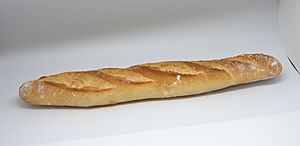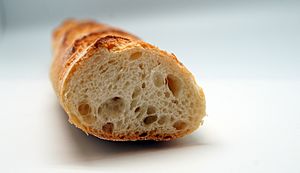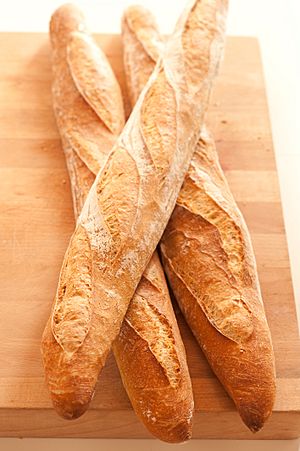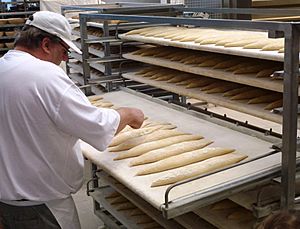Baguette facts for kids
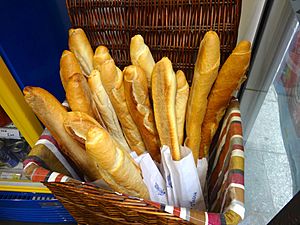 |
|
| Alternative names | French stick |
|---|---|
| Type | Bread |
| Course | Appetizer or Main |
| Place of origin | France |
| Created by | Unknown |
| Main ingredients | Flour, water, yeast, salt |
| Variations | Bánh mì |
| 263 kcal (1101 kJ) | |
| Other information | Glycaemic load 47 (100 g) |
A baguette is a long, thin type of bread that comes from France. It's usually made from a simple dough of flour, water, yeast, and salt. What makes a baguette special is its long shape and its crispy crust.
A baguette is typically about 5 to 6 centimetres (2–2+1⁄2 inches) wide. It's usually around 65 cm (26 in) long, but some can be as long as 1 m (39 in)!
In 2018, the special way of making baguettes was added to France's list of important cultural traditions. Then, in 2022, the art of making baguette bread was even added to the UNESCO Intangible Cultural Heritage Lists. This means it's recognized worldwide as a unique and important part of French culture.
Contents
The Story of the Baguette
The exact history of the baguette isn't fully known, but we do have some interesting facts. Long, stick-shaped breads started becoming popular in France during the 1700s.
In the early 1800s, French bakers began using a very fine type of flour. Later, in 1839, a special way of baking with steam ovens came to Paris. This method helps make the bread lighter and airier. The word "baguette" was first used to describe a specific type of bread in 1920.
So, while no single person "invented" the baguette, all these changes over time helped create the modern baguette we know today. It started in a simple form in the 1700s and slowly became what it is now.
The word baguette means "wand," "baton," or "stick" in French. For example, a magic wand is a baguette magique. It was first officially used for bread in 1920.
Outside of France, the baguette is a famous symbol of French culture. Long loaves have been made in France for a very long time, even since the time of King Louis XIV. Some old accounts describe loaves that were much longer than today's baguettes, like "loaves of bread six feet [1.8 m] long!"
Steam ovens played a big role in the baguette's development. These ovens use steam to help the crust expand before it gets firm. This makes the bread lighter and airier inside. It also gives the crust a slightly shiny look.
Every April in France, there's a competition called Le Grand Prix de la Baguette. Nearly 200 bakers compete to see who makes the best baguettes. Judges look at how the bread is baked, its appearance, smell, taste, and the inside texture. The winner gets money and gets to supply the French president with their daily bread for a whole year!
After the World Wars, French bakers started making baguettes that were whiter and softer. These new breads took less time to make. However, they didn't taste as strong as the older, darker loaves. People also started eating less bread overall.
In 1993, the French Parliament passed a law called Le Décret Pain (The Bread Decree). This law says that "traditional French bread" must be fully mixed, shaped, and baked where it's sold. It also set strict rules for what ingredients can be used in traditional French baguettes. This helped protect the quality of the classic baguette.
Fun Stories About How Baguettes Started
Since the full history of the baguette isn't completely clear, some fun stories have been told about how it might have begun.
One story says that Napoleon Bonaparte created the baguette. He supposedly wanted soldiers to carry bread more easily. Since round breads took up too much space, he asked for them to be made into a skinny stick shape. This way, they could fit into soldiers' uniforms.
Another story suggests baguettes were invented to stop French subway workers from carrying knives. The workers used knives to cut their bread and sometimes got into fights. So, managers asked for bread that could be easily ripped apart, removing the need for knives. The skinny, easy-to-tear baguette would have been the perfect solution.
Some people believe baguettes were the "Bread of Equality" after the French Revolution. A rule was made that one type of bread should be available to everyone, rich or poor.
Another idea is that a law in October 1920 stopped bakers from working before 4 AM. This made it impossible to bake traditional round loaves in time for breakfast. Switching to the thinner baguette solved the problem because it could be prepared and baked much faster.
How Baguettes Are Made and Different Kinds
A "baguette de tradition française" is made with wheat flour, water, yeast, and salt. It can also have small amounts of broad bean flour, soya flour, and wheat malt flour.
Regular baguettes use baker's yeast. More special, artisan-style baguettes often use a "pre-ferment" (called poolish). This helps give them a richer flavor. Some baguettes might also include whole-wheat flour or other grains like rye.
Baguettes are strongly linked to France, but they are made all over the world. In France, not all long loaves are called baguettes. For example, a shorter, thicker loaf is called a bâtard. A thinner loaf is called a ficelle (which means "string").
A flûte is another tubular loaf, similar to a baguette but about twice as big. A short baguette is sometimes called a baton (stick). None of these names are officially defined by law.
French breads also come in other shapes, like a miche, which is a large round loaf, and a boule, which means "ball" in French. Smaller, sandwich-sized loaves are sometimes called demi-baguettes.
Italian baguettes, or baguette italienne, often have more spices and a denser texture. This gives them a slightly different, more Italian taste. Un pain viennois is a type of bread that is much sweeter and softer than a standard baguette.
In France, a baguette usually weighs around 250 g (8+3⁄4 oz). A bâtard weighs about 500 g (17+1⁄2 oz), and a ficelle about 100 g (3+1⁄2 oz). These weights can change depending on where you are in the country.
Baguettes are often used for sandwiches, especially long ones like submarine sandwiches. They are also sliced and served with pâté or cheese. For a traditional French breakfast, slices of baguette, called tartines, are spread with butter and jam. People often dip them into bowls of coffee or hot chocolate.
Baguettes are usually shaped by hand, using folding and rolling movements. They are then left to rise in special cloth-lined baskets or on a floured towel. They are baked directly on the hot surface of a deck oven or in special pans with holes. These pans help keep the baguette's shape while letting heat through.
In recent years, more people in France have been asking for baguettes that are only partly baked. Some bakeries offer different levels of baking, from "well done" to "golden" or "white."
Outside of France, baguettes are also made with different types of dough. For example, the Vietnamese bánh mì uses a lot of rice flour. Many bakeries in North America make whole wheat, multigrain, and sourdough baguettes. Even classic French recipes can vary, with some adding small amounts of milk, butter, sugar, or malt extract for different flavors.
How Many Baguettes Are Eaten?
People love baguettes! Algeria eats about 49 million baguettes every day. France, where they come from, eats about 30 million baguettes daily.
See also
 In Spanish: Baguette para niños
In Spanish: Baguette para niños


